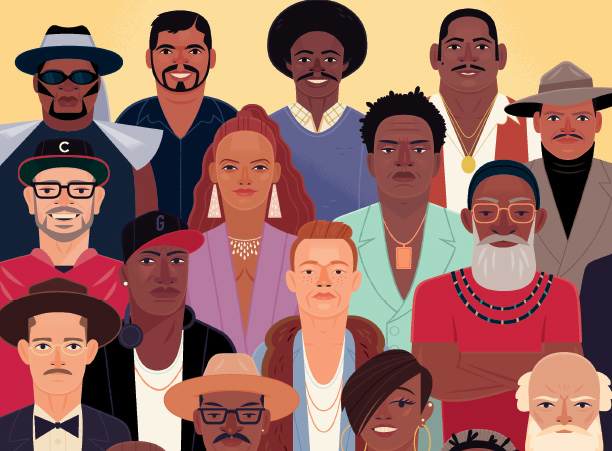
I'd been a hip-hop music fan from grade school, when a Catholic kid's idea of rebellion was bellowing Blondie's "Rapture" a cappella on the school bus until the driver screamed. I graduated to old-school hip-hop classics, "Rapper's Delight," "White Lines" and "Jam on It," delighting in warp-speed rhyming you could dance to. When I got to Holy Cross, UB40 and U2 were the music of the moment, so I shelved Grandmaster Flash and the Sugarhill Gang.
Still, my relationship with hip-hop continued, through the poetry of Langston Hughes, introduced to me by Professor B. Eugene McCarthy. My study of stained-glass windows under Professor Virginia Raguin allowed me to see allegory at work in the street art of hip-hop pioneer Fab 5 Freddy and New York neo-expressionist Jean-Michel Basquiat. And in 2018, when Vanity Fair hailed Pulitzer Prize-winning rapper Kendrick Lamar the heir to James Joyce, I understood that because of Professor Edward Callahan's teaching of "Ulysses" and the epic as a mutable form.
Not that I understood that at the time.
Last year, I was assigned a short profile about a hip-hop pioneer who's been rapping for 30 years. It turned into a five-part series as I realized that hip-hop — which some may view as misogynistic, homophobic, violent, obscene, profane or racist — is also high art and more.
Hip-hop is an artistic and cultural movement with a language and an aesthetic built upon four pillars: MCing (aka, rapping), deejaying, breakdancing and graffiti writing. Bronx-born, hip-hop is the street-smart child of disco, funk, reggae, dance and R&B grown to Goliath proportions, powering a $10 billion-a-year industry.
The more I learned, the more awed I was. Hip-hop artists so revere words that they profane them. They add and subtract letters at will. They stretch and pull words like gum wound round the finger. They take two words and smash them together. They take one word and split it like an atom. And the fallout is music — and more: insight into the human condition, the outpouring of a soul expressing love, lust, anger, frustration, hatred, unity, pride, virtue and vice. It's all there in an art form born of urban poverty, where cardboard was the dance floor; the voice, the instrument and mic; and the street corner, the stage.
Scholar and literary critic Sir Geoffrey Hill wrote that poetry fights "the inertial drag of speech." Hip-hop is airborne. Its most gifted practitioners are revolutionaries, delivering depth charges that happen at the level of the sentence, if not the word. Even its criticism pulsates. Poet Kevin Coval writes, "The break down, polyrhythmic, funky sections of records extended by Kool Herc, Afrika Bambaataa and Grandmaster Flash [laid] a sonic foundation for the largest global youth culture in the history of the planet rock." This culture sounds its barbaric yawp, slams its poetry and dances in "pop and lock and spin . . . defying the limitations of body and gravity," Coval says. Hip-hop artists are Whitman's heirs, the type of epic poet-inventors Shelley envisioned in "A Defence of Poetry."
Hip-hop soars while doing heavy lifting, acting as a conduit for literature, philosophy, art, music, social justice, theatre, history and advocacy. Hip-hop artist and activist Xiuhtezcatl Martinez uses the medium to raise awareness about climate change. Jay-Z, Macklemore and Ryan Lewis use it to preach acceptance and inclusion of the LGBTQ community.
Of course, the art form has, at times, been rightly criticized for all of the reasons I mentioned earlier. Much like Picasso has been criticized for misogyny, Twain for racism and coarse language, and Bukowski for misanthropy and vulgarity. And then there's Joyce, who was well-acquainted with critics' charges of the lewdness, pornography and blasphemy in his work. But criticism is just opinion and art never promised to be pleasing.
I can offer no proof, but I am pretty sure I'm one of the few 52-year-old white women who couldn't wait to buy "There Existed an Addiction to Blood," the 2019 release from experimental hip-hop group clipping. I know many, however, who paid a premium to see the group's lead, rapper Daveed Diggs, play Thomas Jefferson in the Broadway musical "Hamilton." And your kids and grandkids adore him as Mr. Noodle on "Sesame Street." Hip-hop culture is everywhere and we are the richer for it.
All that said, I know some people will never accept that Kendrick Lamar is the contemporary Joyce or that hip-hop is the epic's heir. And that's OK: I bet there were Greeks who thought Homer wouldn't last, either.
Hip-Hop 101 Playlist
"All The Stars" Kendrick Lamar & SZA; "Alexander Hamilton" (Original Broadway Cast of Hamilton); "As We Enter" Nas & Damian "Jr. Gong" Marley; "Bomb Intro/Pass That Dutch" Missy Elliot; "Can't Feel My Face" The Weeknd; "Can't Hold Us" Macklemore & Ryan Lewis (feat. Ray Dalton); "Crazy In Love" Beyonce feat. Jay-Z; "DNA" Kendrick Lamar; "Doo Wop (That Thing)" Lauryn Hill; "Hands in the Air" Timbaland (feat. Ne-Yo); "i" Kendrick Lamar; "Just Fine" Mary J. Blige; "Lose Yourself" Eminem; "Miami" Will Smith; "Mo Money Mo Problems" The Notorious B.I.G. (feat. Mase & Puff Daddy); "My Shot" (Original Broadway Cast of Hamilton); "Rapper's Delight (Hip-Hop Remix Long Version)" The Sugarhill Gang; "Rapture (2002 Remaster)" Blondie; "Run for Your Life" clipping. (feat. La Chat); "Same Love" Macklemore & Ryan Lewis (feat. Mary Lambert); "Temperature" Sean Paul; "The Light" Common; "White Lines (Long Version)" Grandmaster Flash & The Furious Five; "Yeah!" Usher (feat. Lil Jon & Ludacris)
Written by Marybeth Reilly-McGreen '89 for the Winter 2020 issue of Holy Cross Magazine.
About Holy Cross Magazine
Holy Cross Magazine (HCM) is the quarterly alumni publication of the College of the Holy Cross. The award-winning publication is mailed to alumni and friends of the College and includes intriguing profiles, make-you-think features, alumni news, exclusive photos and more. Visit magazine.holycross.edu/about to contact HCM, submit alumni class notes, milestones, or letters to the editor.
